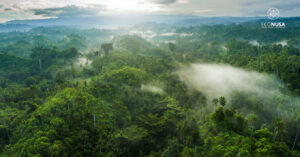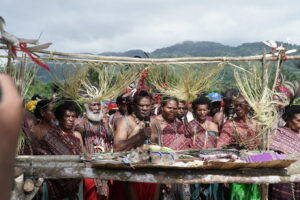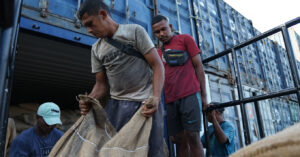
Who would have thought, Manyaifun Village, a remote village in Waigeo Barat Kepulauan District, Raja Ampat Regency, West Papua, has amazing natural potential. Besides having a beautiful natural scenery, the diversity of marine biology is incomparable. There we can find the typical animals of Raja Ampat waters, namely Manta Rays.
Manta Rays are beautiful fish that live in tropical waters. This animal is known to be friendly and often swim with divers. This fish is quite difficult to find, but we can find it in Manyaifun Village.
One of the wealths of Manyaifun village is the sago tree forest. Sago trees can be used for a variety of needs such as staple food, raw materials for walls and roofs of homestay construction, manufacturing of mats or senates, and knitted sago leaves.
Unfortunately, the potential that is there has not been maximally managed. The people there do not yet have the knowledge to develop their regional potential. Even though the tourism sector especially ecotourism can be highlighted to increase the income of the village community. In addition, access is quite difficult and remote areas make Manyaifun village has not received special attention.
The village that is lined up along the shoreline only has 80 families. The main livelihood of the head of the family or commonly called pace is to become a fisherman. Whereas the mama or mama there help to make money by making a senate.
“In the past, the mothers here were gardening, because there were no pigs. Now there are already pigs, so our gardens have been destroyed so we don’t plant anymore, “said Mariam, one of the senate craftsmen from Manyaifun Village (11/6). The mama-mama activities there every day become senate craftsmen. The Ayaman mat is made to be used alone or sold to islands in Raja Ampat to Sorong.
Mama Aisyah, leader of the senate craftsmen group, explained that the production of ayam was uncertain. In addition to personal use, the production of large quantities of crocodiles is very rare. Mothers will only produce cushions if there is demand. “Fear of not selling if you make a lot and leave it in the market. “There is no market here, so it takes three hours to send the senate to the market and expensive gasoline,” he said.
In addition, some families have homestay businesses. There are eight families who have this business. Unfortunately, the management of homestay was not in accordance with the standard standards of homestay governance and the promotion strategy was minimal. Local community homestays pay less attention to cleanliness, comfort and safety standards.
Even though homestay is one of the facilities needed by tourists to be comfortable visiting Manyaifun Village. There is also no collaboration between the community and homestay businesses even though this collaboration is important to market their craft. “The people here don’t feel they have a homestay yet. Because they still have individuals and have not felt the community, “Kris said as Chairman of the Association of Raja Ampat Indigenous People and Livelihood Association (Pejampat).
To maximize the potentials of the Manyaifun Kampung area, the EcoNusa Foundation is working with the Association of Perjampat to provide support and knowledge to the community in Manyaifun Village in the form of training. This project is supported by one of the homestay associations who have received awards for indigenous community-based homestay management.
Existing training in the form of the formation of women’s and youth groups in the management and development of local souvenirs and environmentally friendly homestay training in accordance with the standard standards of homestay governance. After this training, community groups were helped, for example in making souvenirs such as the senate (mat) and coconut oil, more quickly because mutual cooperation was carried out. “Previously we worked on souvenirs individually so it requires a long time. If it used to take 2 to 3 days to work on, now it only takes three hours to work, “Mariam said. The results of these products are marketed on the website channel which is now a reference for tourists to Raja Ampat.
“Hopefully this group of mothers can keep on going. We also want to be able to create a place for souvenir shops. If a homestay guest comes, we can also take a tour around the village, then stop by the souvenir house, “Mariam said.
In addition, there are also environmentally friendly homestay training. Communities are given knowledge about the standards of reference for homestay governance, including the importance of business communities having environmental licensing letters and preserving the environment and sago forests.
Unfortunately, after the training, the community still had not made efforts to improve homestay standards. For example, they have been given training related to the separation and management of organic and inorganic waste, conservation of the village through weekly environmental clean up actions (clean Friday), and the provision of the final waste bin in the village. But the only thing running was clean Friday activity. When asked why they have not used the facilities made, the answer is because they say there is no garbage that must be disposed of in a landfill. Be, garbage piled up on the edge of their house. This lack of public awareness about environmental cleanliness is still the homework.
According to Kris, this is the first time they have implemented a homestay program involving the community. Usually they work with entrepreneurs. Community enthusiasm for getting training is quite high. The community is happy with this program. “The difference is very clear, just a small example when we came, our people asked to gather they immediately came up with enthusiasm. If employers are difficult to get together. The community is happy with this program, because they get new insights, “he explained.
The training runs within four months. The training which was held at the beginning of 2019 did not provide maximum results for the community. Although the results have not been maximized, this training has provided changes to the community. The changes are for example an increase in income for the craftsmen group, a clean Friday program to maintain environmental cleanliness, a routine planting of sago trees to maintain its sustainability, and others. So, little by little the community can better utilize the potential of their area.




